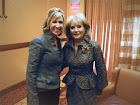"There are many doctors who disagree with doctors saying women over 35 will have a much harder time becoming pregnant and maintaining a pregnancy. There are many physicians who believe that, if older women are healthy, there is a lesser risk in becoming pregnant than some believe."-Ms. PH I think the following information about conception may be helpful after getting this comment from a newsanchormom.com reader:
I think the following information about conception may be helpful after getting this comment from a newsanchormom.com reader:
That's why I thought I would post this story from a health company called Medstar. It is about a test you can take to find out how many eggs you have left.
Fertility Forecaster:
Female Infertility :
Infertility is the inability to become pregnant after one-year of unprotected intercourse. According to the Hormone Foundation, about 3 million couples in the U.S. are infertile. In 40 percent of cases, the problem is with the woman. Male factors are involved in about 30 percent of infertility. For 20 percent of couples, it is caused by a combination of problems in the woman and man. In 10 percent of couples, the cause is unknown. There are several factors that can increase the risk of infertility in a woman. About 40 percent of cases of female infertility are caused by ovulation problems. Imbalance of hormones, pituitary tumors, excessive body weight or severe underweight can cause problems with the release of a healthy egg. Infertility can also be caused by thyroid problems, polycystic ovary disease, excessive use of alcohol, use of certain drugs, damage to the fallopian tubes, uterine polyps, endometriosis, fibroids, adhesions or uterine abnormalities.
Age as a Factor in Female Fertility:For women, the chance of becoming pregnant declines with age. A healthy 30-year-old woman has about a 30 percent chance per month of becoming pregnant. By 40, the monthly chance of becoming pregnant drops to 5 percent. In fact, the American Society of Reproductive Medicine estimates 29 percent of women 40 to 49 are infertile. One of the problems older women face is a decline in healthy eggs. Females are born with all the eggs they ever produce. Many of those eggs die off naturally, so the supply dwindles with age. When a baby girl is born, she has one to two million eggs. By the time she reaches puberty, the number of eggs in the ovaries is down to about 400,000. Each month, hundreds of eggs will begin to mature. But only about one or two of them will survive to maturity for release during ovulation. As a woman ages, egg quality begins to decline. In addition, after 35, declining hormone levels can lead to less frequent ovulation. Occasionally, a woman may go through a menstrual cycle where an egg is not released.
Predicting Fertility:
The National Center for Health Statistics reports there were more than 4 million births in the U.S. in 2003. The number of births to women in their twenties was down one percent from 2002. But the number of births for women in their thirties increased by four percent. For women in their forties, the increase was five percent. As more women delay having their first child, many are facing questions about their ability to conceive. While tests are available to directly observe the numbers and quality of male sperm, there is no direct method to verify the numbers and quality of remaining eggs. Doctors can make a judgment of FERTILITY based on a woman’s age, health, menstrual history, measures of hormones associated with ovulation, and images or biopsy of reproductive structures. AUDIENCE INQUIRY:
For general information on infertility: American College of Obstetricians and Gynecologists, public website, http://www.medem.com
American Pregnancy Association, http://www.americanpregnancy.org
American Society for Reproductive Medicine, http://www.asrm.org
The Hormone Foundation, http://www.hormone.org
NCIID (The InterNational Council on Infertility Information Dissemination, Inc.), http://www.inciid.org
RESOLVE: The National Infertility Association, http://www.resolve.org




.jpg)













1 comments:
Is the prevalence of "birth defects" greater among children born of older mothers and fathers? Is there a correlation between ova mosaicism and genetic anomalies among older mothers?
Post a Comment